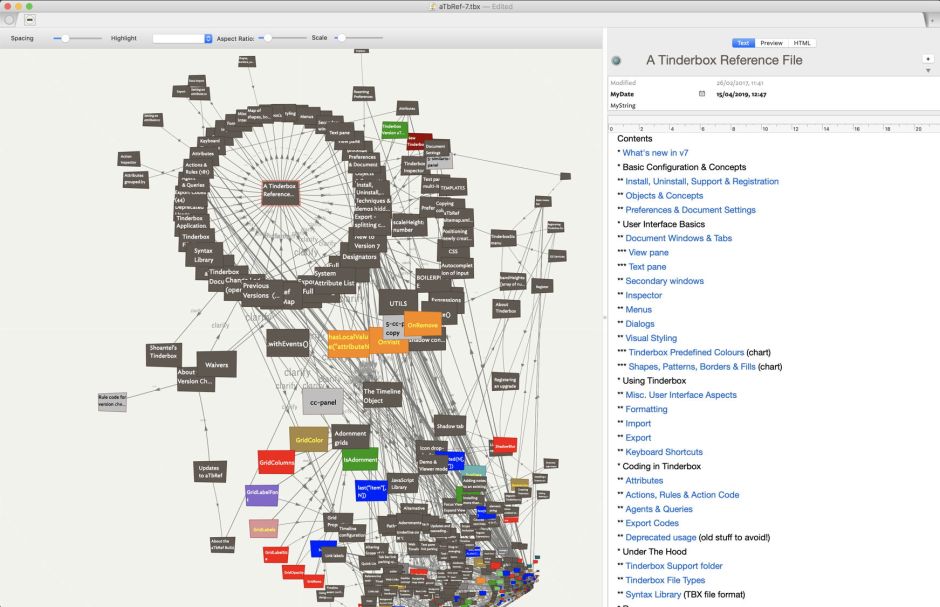There aren’t many apps I have been using since the first public release of what was then Mac OS X. One is the text editor BBEdit, which has just celebrated its twenty-fifth birthday and is now available in the App Store. The other two are both products of Eastgate Systems: Tinderbox and its sister Storyspace.
If you’re looking for the notes app which will comfortably handle anything from quick one-line jottings to vast web-linked ecosystems, the shortlist consists of Tinderbox alone. Over the years, I’ve used it fitfully for anything from a scrapbook of source code and creating Help books, to viewing timelines in the development of painting.
For the last few years, I’ve had a regular monthly appointment with Tinderbox, which acts as my database for all the Q&A sections that I have written for MacFormat magazine. I now have over six hundred questions and answers amounting to 85,000 words at my fingertips, ready to tell me if I’ve duplicated any, and to track which subjects I’ve already covered. And that’s just scratching the surface of its capabilities.
The reason for this eulogy on what must be one of the Mac’s greatest and most singular apps is the release of its new version 8, which is currently available at introductory discount prices from Eastgate.
The big new features in this version include:
- Hyperbolic Views, which I’ll show later;
- Filtered Outlines;
- Substantial improvements in Map Views;
- Scripting support;
- A lot of internal code improvements to make the whole app faster and more responsive.
I haven’t had this new version long, so exploring most of those and the more than dozens of other significant improvements will come over the next few weeks. However, I’ve already noticed how much nimbler Map Views are, and will show a couple of examples of the new Hyperbolic View to show the most obvious reasons for upgrading.
Like most users, I suspect, I tend to work in Map View much of the time. In Tinderbox 7, this did creak occasionally, although never enough to annoy. Version 8 has a lot of layout improvements, and feels a great deal sleeker. Alignment is better, and there are some neat improvements for notes containing images; for example, notes that start with images now have those shown on the face of the note automatically, which for my art projects is ideal.
Hyperbolic Views are designed for use with linked notes, one of Tinderbox’s most powerful features which lends itself to brainstorming and structured design. Starting from any selected ‘focus’ note, the app identifies those other notes which are linked to and from it. This process of tracing the link network then extends outwards to show all notes which are indirectly linked to the focus. These are projected onto a hyperbolic plane, which you can navigate easily with gestures.

For my modestly-linked documents, Hyperbolic View gives clarity to link structure which I already see becoming invaluable.

It really comes into its own, though, as documents and their linkage become more complex. This monster is one of Mark Anderson’s Tinderbox Reference Files in its full glory. For anyone developing linked narrative, like Mark Bernstein’s hypertext novel Those Trojan Girls (highly recommended, and available from Eastgate), this looks like a godsend.
Tinderbox 8’s AppleScript Dictionary contains a full Standard Suite, and custom nouns to give access to its documents, notes, agents, adornments, selections, and attributes. These support actions such as finding a note in, parents, children and siblings of notes, and finding named attributes. These should make it much easier to integrate Tinderbox with other apps, something in which it already excels.
For those who’ve been frustrated with Apple’s Notes and some other products, Tinderbox doesn’t try saving your work in an SQLite database. It remains firmly committed to a traditional document model, which is ideal when you use it for so many different purposes.
For me, the only slight disappointment in Tinderbox 8 is its lack of explicit support for Dark Mode in Mojave. You can always set your documents up to look good in Dark Mode, but I don’t see any simple way to create a single document which switches its appearance when I switch mode. This isn’t a big issue, though, as Tinderbox’s bundled colour schemes avoid extremes of lightness, and their default is comfortable in both appearance modes.
Tinderbox 8 isn’t cheap, but it’s the only note app which can accommodate almost any requirement, and encourages you to make more use of its huge range of features, rather than stifle you in what its authors think you should be stuck with. Eastgate is also very accommodating over pricing models: when you buy or upgrade, you automatically get a year’s free updates. A year later, you then choose whether you wish to pay a third of that initial cost for free updates for another year, or leave it until there’s an upgrade you want to pay for. Needless to say, I maintain an annual update subscription, but why can’t other vendors give users this sort of choice?
If you make notes of any kind, download a copy of Tinderbox 8 and give it a try as a free demo. I’ll be surprised if you’re not as smitten with it as I am, and have been since version 1.0.
